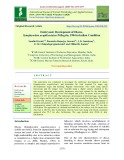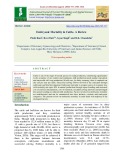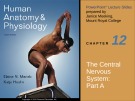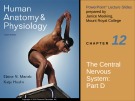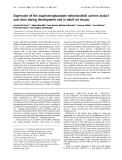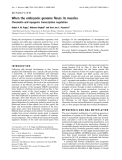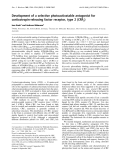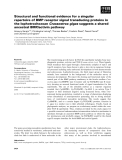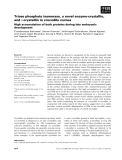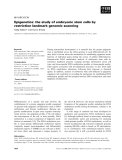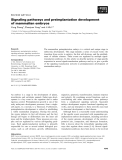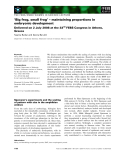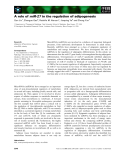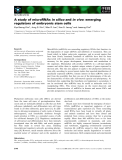
Embryonic development
-
Organogenesis is crucial for proper organ formation during mammalian embryonic development. However, the similarities and shared features between different organs and the cellular heterogeneity during this process at single-cell resolution remain elusive.
 20p
20p  vimichaelfaraday
vimichaelfaraday
 25-03-2022
25-03-2022
 20
20
 1
1
 Download
Download
-
The ingestion of the fungicide in the larval stage can impair the bee development and the health and performance of the colony. In this perspective, studies that consider the effects of fungicides in the different stages of bee development are crucial for a better interpretation of the risks of exposure.
 9p
9p  thebadguys
thebadguys
 15-01-2022
15-01-2022
 12
12
 3
3
 Download
Download
-
The experiment was conducted to investigate the embryonic development of discus (Symphysodon aequifasiatus) and determine the time required for major egg developmental stages and hatching. Regular observations were made using optical microscope and the images were recorded using a digital camera attached to the microscope. Important water quality parameters were kept optimal for the hatching of discus eggs.
 8p
8p  nguaconbaynhay7
nguaconbaynhay7
 15-08-2020
15-08-2020
 11
11
 1
1
 Download
Download
-
The evaluation and treatment of internalizing disorders in children and adolescents has a long and rich tradition in the psychology and clinical psychiatry of the child. However, the use of longitudinal data to elucidate the evolution and outcome of these conditions, as well as their assessment and treatment, is less developed in the embryonic development stage.
 12p
12p  christabelhuynh
christabelhuynh
 04-06-2020
04-06-2020
 18
18
 2
2
 Download
Download
-
Cattle is one of the major livestock species for milk production, contributing significantly to the economy of our country and continuous milk production needs regular conception and successful calf crop production. World-over, for dairy economy, there is emphasis on one calf per year per cattle. Successful calving follows survival of the conceptus through embryonic and fetal development.
 16p
16p  nguaconbaynhay5
nguaconbaynhay5
 16-05-2020
16-05-2020
 7
7
 1
1
 Download
Download
-
Chapter 12 - The central nervous system (part a), the topics discussed in this chapter are: Central Nervous System (CNS), embryonic development, effect of space restriction on brain development, regions and organization of the CNS, ventricles of the brain,...and other contents.
 60p
60p  tangtuy07
tangtuy07
 02-04-2016
02-04-2016
 38
38
 2
2
 Download
Download
-
After completing this unit, you should be able to: Describe the embryonic development of the spinal cord; describe the gross and microscopic structure of the spinal cord; list the major spinal cord tracts, and classify each as a motor or sensory tract; distinguish between flaccid and spastic paralysis, and between paralysis and paresthesia;...
 49p
49p  tangtuy07
tangtuy07
 02-04-2016
02-04-2016
 47
47
 3
3
 Download
Download
-
Aralar1 and citrin are members of the subfamily of calciumbinding mitochondrial carriers and correspond to two isoforms of the mitochondrial aspartate/glutamate carrier (AGC). These proteins are activated by Ca2+ acting on the external side of the inner mitochondrial membrane. Although it is known that aralar1 is expressed mainly in skeletal muscle, heart and brain, whereas citrin is present in liver, kidney and heart, the precise tissue distribution of the two proteins in embryonic and adult tissues is largely unknown....
 8p
8p  system191
system191
 01-06-2013
01-06-2013
 34
34
 4
4
 Download
Download
-
During the development of multicellular organisms, both transient and stable gene expression patterns have to be established in a precisely orchestrated sequence. Evidence from diverse model organisms indicates that this epigenetic program involves not only transcription factors, but also the local structure, composition, and modification of chromatin, which define and maintain the accessibility and transcriptional competence of the nucleosomal DNA template.
 6p
6p  research12
research12
 01-06-2013
01-06-2013
 33
33
 4
4
 Download
Download
-
Anovel photoactivatable analog of antisauvagine-30 (aSvg-30), a specific antagonist for corticotropin-releasing factor (CRF) receptor, type 2 (CRF2), has been synthesized and characterized. TheN-terminal amino-acidD-Phe in aSvg-30 [D-Phe11,His12]Svg(11)40) was replacedbyaphenyldiazirine, the 4-(1-azi-2,2,2-trifluoroethyl)benzoyl (ATB) residue.
 7p
7p  tumor12
tumor12
 22-04-2013
22-04-2013
 31
31
 3
3
 Download
Download
-
The transforming growth factorb(TGF-b) superfamily includes bone mor-phogenetic proteins, activins and TGF-bsensu stricto (s.s). These ligands, which transduce their signal through a heteromeric complex of type I and type II receptors, have been shown to play a key role in numerous biologi-cal processes including early embryonic development in both deuterostomes and ecdyzozoans.
 17p
17p  fptmusic
fptmusic
 11-04-2013
11-04-2013
 26
26
 2
2
 Download
Download
-
Prion diseases are characterized by the accumulation of a pathogenic mis-folded form of a prion protein (PrP) encoded by the Prnpgene in humans. In the present study in zebrafish, two transcripts and the corresponding genes encoding prion proteins, PrP1 and PrP2, related to human PrP have been characterized with a relatively divergent deduced amino acid sequence, but a well preserved overall organization of structural prion pro-tein motifs.
 14p
14p  awards
awards
 05-04-2013
05-04-2013
 39
39
 2
2
 Download
Download
-
Several enzymes are known to accumulate in the cornea in unusually high concentrations. Based on the analogy with lens crystallins, these enzymes are called corneal crystallins, which are diverse and species-specific. Exam-ining crystallins in lens and cornea in multiple species provides great insight into their evolution.
 11p
11p  inspiron33
inspiron33
 25-03-2013
25-03-2013
 50
50
 4
4
 Download
Download
-
Glial cell line-derived neurotrophic factor family ligands act through the receptor tyrosine kinase Ret, which plays important roles during embryonic development for cell differentiation, survival, and migration. Ret signaling is markedly affected by compartmentalization of receptor complexes into membrane subdomains.
 12p
12p  media19
media19
 06-03-2013
06-03-2013
 34
34
 2
2
 Download
Download
-
During mammalian development, it is essential that the proper epigenetic state is established across the entire genome in each differentiated cell. To date, little is known about the mechanism for establishing epigenetic modi-fications of individual genes during the course of cellular differentiation.
 7p
7p  media19
media19
 06-03-2013
06-03-2013
 35
35
 3
3
 Download
Download
-
Vascular endothelial growth factor (VEGF) family members play impor-tant roles in embryonic development and angiogenesis during wound healing and in pathological conditions such as tumor formation. Parapox-viruses express a new member of the VEGF family which is a functional mitogen that specifically activates VEGF receptor (VEGFR)-2 but not VEGFR-1.
 11p
11p  media19
media19
 05-03-2013
05-03-2013
 26
26
 3
3
 Download
Download
-
The mammalian preimplantation embryo is a critical and unique stage in embryonic development. This stage includes a series of crucial events: the transition from oocyte to embryo, the first cell divisions, and the establish-ment of cellular contacts.
 11p
11p  media19
media19
 04-03-2013
04-03-2013
 36
36
 2
2
 Download
Download
-
We discuss mechanisms that enable the scaling of pattern with size during the development of multicellular organisms. Recently, we analyzed scaling in the context of the early Xenopusembryo, focusing on the determination of the dorsal–ventral axis by a gradient of BMP activation.
 12p
12p  vinaphone15
vinaphone15
 27-02-2013
27-02-2013
 38
38
 1
1
 Download
Download
-
MicroRNAs (miRNAs) are involved in a plethora of important biological processes, from embryonic development to homeostasis in adult tissues. Recently, miRNAs have emerged as a class of epigenetic regulators of metabolism and energy homeostasis.
 11p
11p  viettel02
viettel02
 22-02-2013
22-02-2013
 34
34
 3
3
 Download
Download
-
MicroRNAs (miRNAs) are noncoding regulatory RNAs that function via the degradation of target mRNAs and inhibition of translation. They are found widely in higher eukaryotic organisms, and in several species that have been closely examined, hundreds of miRNAs have thus far been discovered with mechanistically conserved, yet functionally diverse, roles necessary for the proper development, homeostasis and metabolism of the organisms.
 10p
10p  viettel02
viettel02
 22-02-2013
22-02-2013
 44
44
 3
3
 Download
Download
CHỦ ĐỀ BẠN MUỐN TÌM










